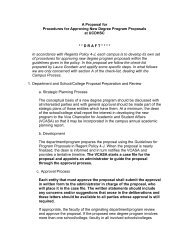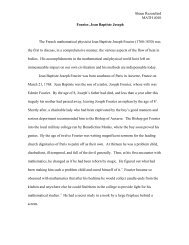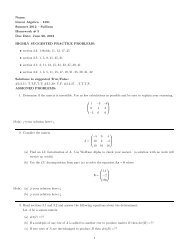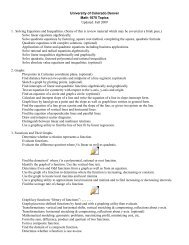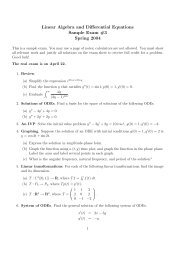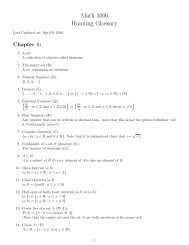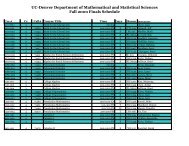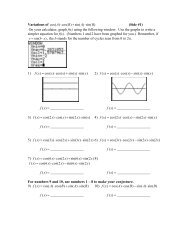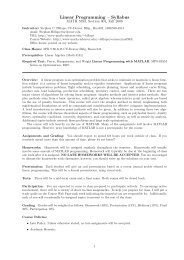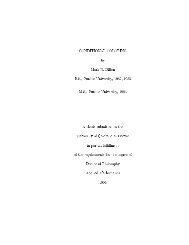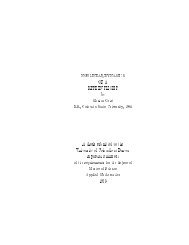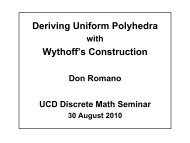A Game-Theoretic Approach to Personnel Decisions in American ...
A Game-Theoretic Approach to Personnel Decisions in American ...
A Game-Theoretic Approach to Personnel Decisions in American ...
You also want an ePaper? Increase the reach of your titles
YUMPU automatically turns print PDFs into web optimized ePapers that Google loves.
∂R∗ ∂x = (ar,p − ar,r)(ap,r − ap,p)(1 − δ)<br />
D2 . (8)<br />
Our assumption about the <strong>in</strong>itial payoffs, specifically that ar,p > ar,r<br />
and ap,r > ap,p imply that ∂R∗ > 0. This is quite unexpected, as it suggests<br />
∂x<br />
that as a team’s pass<strong>in</strong>g game improves, the team should actually pass less<br />
than it did previously!<br />
5 Predict<strong>in</strong>g the Impact of Jay Cutler on the<br />
Play Selection of the 2009 Chicago Bears<br />
In this section, we utilize our model <strong>to</strong> make a prediction relevant <strong>to</strong> the 2009<br />
NFL season by consider<strong>in</strong>g the effect of new quarterback Jay Cutler on the<br />
play selection of the Chicago Bears. Recall that <strong>to</strong> f<strong>in</strong>d the payoffs for Table<br />
1 <strong>in</strong> the manner described above, the defensive strategies “Defend Run” and<br />
“Defend Pass” must be clearly def<strong>in</strong>ed and the number of times each strategy<br />
is employed must be accurately tallied. In our computational analysis below,<br />
we utilize data from past NFL seasons, but we do not explicitly determ<strong>in</strong>e<br />
the number of times the defense chose each strategy. Instead, we attempt <strong>to</strong><br />
approximate these values. While this is not optimal, we aga<strong>in</strong> po<strong>in</strong>t out that<br />
a serious team’s coach<strong>in</strong>g staff would have ready access <strong>to</strong> the necessary data.<br />
In his fourth NFL season, Jay Cutler is among the more promis<strong>in</strong>g<br />
young quarterbacks <strong>in</strong> the league. In the 2008 season, he f<strong>in</strong>ished 3 rd <strong>in</strong> the<br />
NFL <strong>in</strong> <strong>to</strong>tal pass<strong>in</strong>g yardage and was subsequently traded from Denver <strong>to</strong><br />
Chicago. For Bears fans, this is good news, s<strong>in</strong>ce <strong>in</strong> the past five seasons the<br />
Chicago Bears have f<strong>in</strong>ished no better than 14 th <strong>in</strong> the NFL <strong>in</strong> <strong>to</strong>tal pass<strong>in</strong>g<br />
yardage. With an improvement <strong>in</strong> pass<strong>in</strong>g, Chicago figured <strong>to</strong> be competitive<br />
<strong>in</strong> the NFC. The follow<strong>in</strong>g analysis aims <strong>to</strong> exam<strong>in</strong>e how the acquisition of<br />
Jay Cutler might alter the run/pass balance of the Chicago Bears for the 2009<br />
season.<br />
We first construct the payoff matrix for the Chicago Bears us<strong>in</strong>g empirical<br />
data from the 2008 season. This data determ<strong>in</strong>es the values of the <strong>in</strong>itial<br />
payoffs for the improvement <strong>in</strong> pass<strong>in</strong>g model, as outl<strong>in</strong>ed <strong>in</strong> Section 3. Then,<br />
<strong>to</strong> predict how the mixed strategies change for Chicago, we explore how Jay<br />
Cutler <strong>in</strong>fluenced the expected yardage per play <strong>in</strong> his first season as a starter<br />
<strong>in</strong> Denver. Once this <strong>in</strong>fluence is known, we project it on<strong>to</strong> the 2009 Chicago<br />
Bears improvement <strong>in</strong> pass<strong>in</strong>g model.



